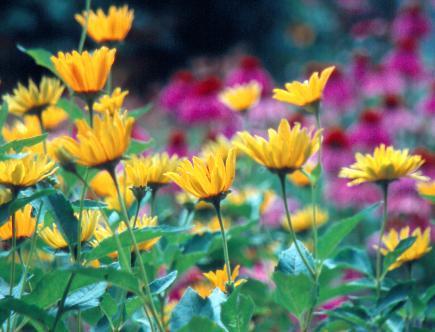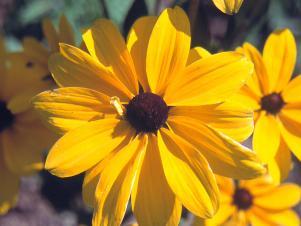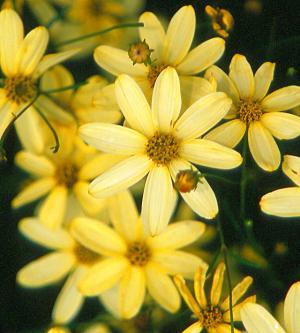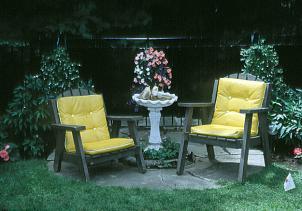
 | |
| Using yellow's complement, violet, is a sure way to make it sing. |
Yellow is cheerful and friendly, as if Mother Nature herself is smiling. It is the colour of sunshine, warm and luminous. After the monotones of winter, bold, clear yellow flowers and foliage such as crocus, species tulips, forsythia and willows are welcome heralds of spring.
Yellow embodies the very essence of spring. Consider the growth of a humble daffodil. Determined green spears poke their way through the cold earth, often before the snow cover has melted away. We marvel as they quickly stretch toward the sun, peeling back papery layers to reveal a hint of colour and finally a single-minded burst of optimistic yellow - spring has arrived!
Yellow is a colour of many personalities. It can be sophisticated, vivacious, gentle or brassy. To add to the confusion, it can be both a warm and a cool colour. By adding increments of red to canary yellow, it warms through shades of gold until it reaches orange. On the other hand, by adding blue to the same canary yellow, it cools and mellows as it approaches green.
 | |
| Aquilegia | |
 | |
| Rudbeckia 'Indian Summer' | |
 | |
| Coreopsis 'Moonbeam' | |
 | |
| Yellow's ability to inject light into a dark environment works with accessories as well as plant material. |
Warm shades of yellow complement a rich border of red, wine and bronze. Trendy blends include Rudbeckia 'Indian Summer', Hemerocallis 'Buddah' and 'Stella D'Oro', with burgundy shades of Miscanthus 'Rubrum' or Cotinus softening the yellow and echoing the burgundy accents found in the perennials. Bold foliage plants such as Miscanthus 'Zebrinus' or Canna with distinctive yellow markings will also show to advantage when combined with golden yarrow or coreopsis.
The warmer shades of yellow are most effective in the fall garden, with golden sunlight softening the picture. As the days grow shorter and cooler, many plants take on burnished or golden accents, gently echoing the golden flowers -- uplifting to the spirit, even on the most grey of afternoons.
Yellow, one of the three primary colours is the brightest colour of the spectrum. Even a tiny splash of yellow will catch and reflect every bit of available light, drawing your eye. (Consider the visibility of one tiny dandelion in an expanse of green lawn.) Violet is the complementary colour for yellow, and so a tiny sprinkling of lemon yellow will enliven sombre plantings of violet-based flowers.
Variegated foliage, such as that of Brunnera 'Hadspen Cream', Hosta 'Stiletto', or Carex morrowii 'Aureovariegata' seem to glow against a dark backdrop of dark green foliage companions. In fact, these beauties appear to be even more luminous in light shade where they will be protected from the scorching mid-summer sun.
Yellow is often the favourite colour of creative, enthusiastic people. In colour therapy, it is believed to stimulate the nerves and brain. It also is said to encourage concentration and study. Yellow is optimistic; it generates energy. It is said to help sort out problems, lift depression and alleviate ailments such as allergies and depression. This may sound far-fetched, but consider the uses and effects of the following familiar yellow subjects, the ever-popular highlighter (used to help you focus); yellow warning lights and construction vehicles (to catch your eye) and daffodils (the symbol of hope for the Cancer Society). In the garden, yellow plants are frequently associated with cheerful descriptions such as buttercups, sunflowers, primrose yellow and moonshine. Before jumping on the yellow bandwagon, a word of caution. I once visited a July garden that was overflowing with yellow flowering plants. At first glance, the effect was lively. However, I quickly grew weary of the exploding colours -- where was my eye to rest? Lemon yellow coreopsis, golden rudbeckia and gaillardia, lady's mantle, and clumps of daylilies tangled into a confusion of bright colours that somehow seemed lifeless and dull. Rather than refresh and focus the mind, this jumble served to confuse. The lesson? Yellow must be used in moderation, taking care not to blend too many shades of yellow together.
For the faint of heart, yellow can be introduced as accents in the garden. A yellow umbrella over a table will glow with an aura of cheerful healing colour. Lounge chairs with bright yellow cushions located in a shady garden seem to welcome visitors.
When in doubt about how to use yellow to the best effect, let Mother Nature be your guide. A field of summer wildflowers sparkles in shades of refreshing white, lemon yellow and blue. By early fall, the same field will be filled with the warm glow of goldenrod and violet asters. Autumn canopies of golden yellow leaves seem to glow in the gentle sunlight, showing to best advantage against a cool blue October sky. These seasonal colour schemes can easily be translated into a variety of refreshing garden plans or cheerful container gardens.
Theresa Forte is a garden columnist, photographer and garden consultant based in Niagara Falls.